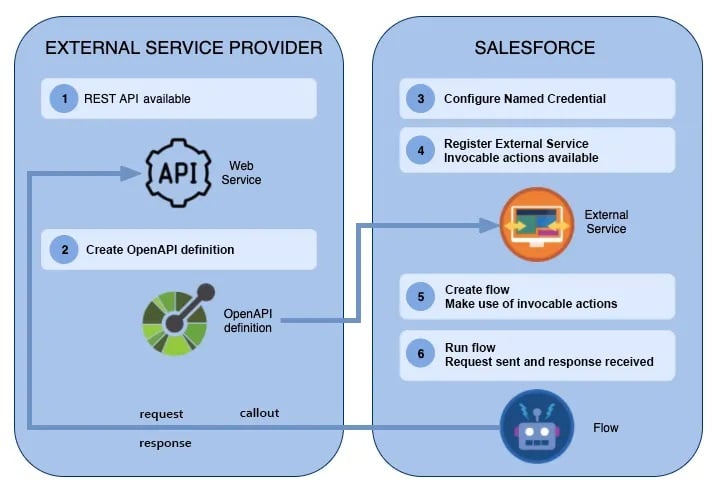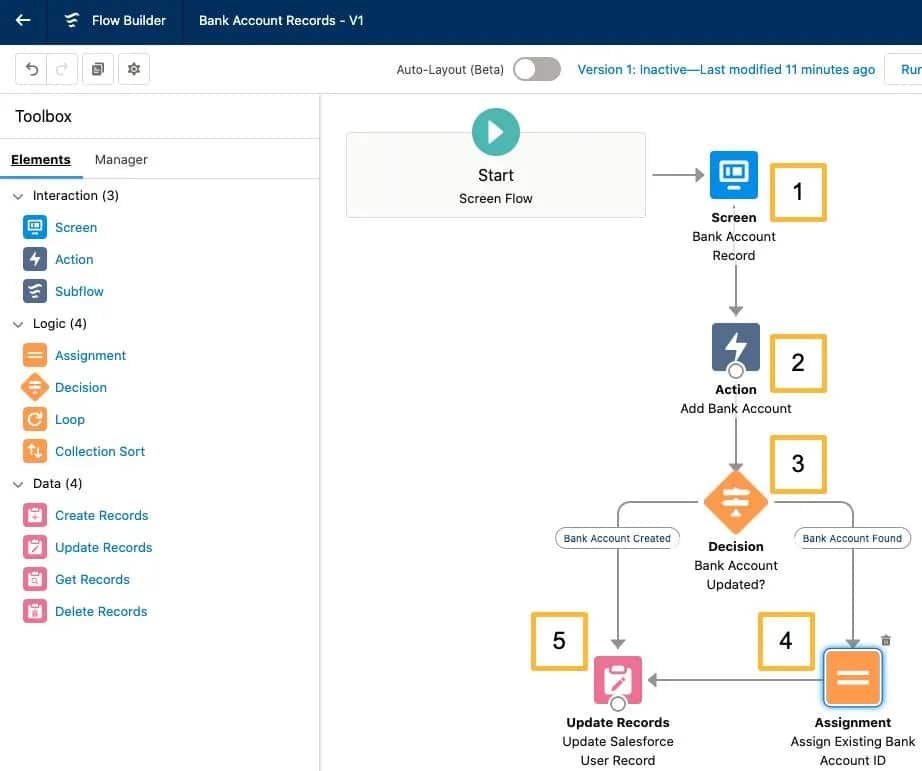
Figure 1: Path to connect Salesforce to an external service provider.
Source: Salesforce Trailhead
Salesforce Flow was released in 2018 as an extension to its low code portfolio of admin and developer tools enabling users to automate business processes using a visual interface quickly. Salesforce Flow experienced rapid adoption as enterprises raced to digitize manual processes in the pandemic era when touchless interaction was the preferred choice for business transactions. Simple transactions like paying a restaurant bill graduated to QR codes printed on the cash receipt with payments made through a smartphone. While digitizing business processes may be perceived as simple, the implementation requires enterprise-grade security and high availability. This blog post examines the role being played by Salesforce Flow in enhancing business productivity and the enhancements to Salesforce Flow announced at the TrailBlazerDX conference held in April 2022.
With the success of Salesforce Flow, this TrailBlazerDX event was an appropriate time for Salesforce to showcase its expanded automation capabilities with improved collaboration, deeper insights, and easier integration, capitalizing on the acquisitions of Slack, Tableau, and Mulesoft, respectively, as described below.
Improved collaboration: Handling a business process often requires collaboration between internal and external stakeholders. For example, accepting an image for an ad campaign may require multiple approvers to be involved. Adding collaborative capability into a workflow can accelerate the review and approval of exceptions. This can be accomplished using legacy development tools, but it requires development resources that can be tedious. Enabling a developer to add Slack collaborative capabilities quickly and securely into a process without coding helps accelerate building of all types of workflow applications.
Deeper insights: Customers can take advantage of insights from Salesforce Flow in multiple ways. One method analyzes the flow of processes to identify the weak spots to be targeted for improvement. Another helpful strategy is to address the shortcomings identified in the process flow by kicking off collaborative processes to fix them. These methods remove inefficiencies in process flows and improve business efficiencies in an organization. Salesforce Tableau has the ingredients to monitor and identify slow processes and remediate inefficiencies. Although these features improve process efficiencies, it would be helpful if Salesforce added in-depth process mining capabilities in the future.
Easier integration: When Salesforce acquired Mulesoft in 2018, several investors asked my opinion on the $7.2B costs, which seemed high in proportion to the Mulesoft revenue. My response was that integration magnifies the value of applications to end-users, and Salesforce customers would benefit from Mulesoft by making the acquisition accretive. Integration is a complicated task for IT professionals with various IT systems. Salesforce continues to reduce the complexity of integrating silos of IT into applications by abstracting all the steps it takes to build a connector. Robotic Process Automation (RPA) delivers integration value for customers with legacy systems while bypassing the need to modify backend systems. Mulesoft capabilities continue to enhance value to developers through a low code interface. Both figures in this write-up are examples of more straightforward integration.
Figure 2: Steps and logic in Salesforce Flow to connect to an external source
Source: Salesforce Trailhead
With Mulesoft, Tableau, and Slack capabilities in the
Salesforce low code portfolio, customers can benefit by expanding application
features with little effort in Salesforce Flow. Salesforce takes advantage of a
common security and data layer to automate the process of matching solution
requirements with application features. The challenge for Salesforce is to
communicate the value of a low code platform to enterprises and make the low
code approach a priority to application development managers.
During the analyst conference, Salesforce shared how
customers start with a subset of products and expand the spending to include
the rest of the product portfolio. Investors should note this expanding revenue
opportunity for Salesforce, while customers should evaluate the current use of
Salesforce products to add new capabilities as necessary.
Other observations:
TrailBlazerDX notes: The TrailBlazerDX conference was
well attended despite coming at the heels of a long pandemic hiatus of
in-person events. The conference attendance demonstrated developers’ passion
for delivering value to their employers by growing skills on the expanded
Salesforce Platform. TrailblazerDX attracted about 10,000 virtual attendees to
consume the learning content provided at the conference and about 5000 in-person
attendees.
Value of the Salesforce Platform: Salesforce
disrupted the software industry by replacing on-premise implementations of CRM
software with subscriptions that significantly improved the sales process. Over
the years, through acquisitions and inhouse innovations, Salesforce expanded
its portfolio to cover many business processes with offerings ranging from
Sales Cloud, Services Cloud, Commerce Cloud, and Marketing Cloud. The
Salesforce Platform has enabled developers to innovate by extending the core
cloud offerings by applications built without a complicated custom coding
effort. Professional developers often choose low code solutions like the
Salesforce Platform as the preferred development tool as changing business
needs accelerate the demand for applications.
Why is Low Code important? Businesses face numerous
challenges that started with the pandemic, followed by the resignation trends
and the recent war. The priority to become adept in addressing current and
future uncertainties with digital transformation has reached the C-suite. Improving
operational efficiency is crucial to enterprises attempting to do more work
with a smaller workforce due to the shortage of qualified employees.
Digitization of processes with legacy systems is expensive and slow, and cloud
vendors are racing to the market with tools to improve business efficiencies.
